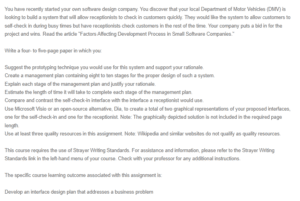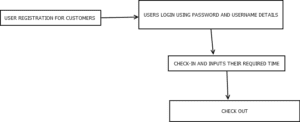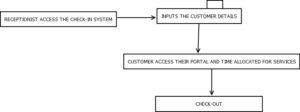Software Design Process
Software prototyping is the software design process of building application prototypes that display the full functionality of the applications under review and may not hold the exact representation of the expected software systems. The software prototyping model has increasingly become the leading approach for developing software systems since it helps understand the customer requirements, implicitly helps give valuable feedback on the application design phase and also allows the developers to understand what’s required as the final output of the software systems.
The proposed systems for allowing receptionists to check in their customers can be designed using the prototype models to help developers understand the user requirement more easily and thus provide a concrete implementation plan for the software systems. The modules for the systems will include the following elements:
- Registration module – that keeps the updated registers of all the customers who checked in the local Department of Motor Vehicle database and thus develops an updated real-time list of the customers, their check-in and check-out time frame, and all the updated issues for requests for services within the organization.
- Authorization and authentication modules that keep track of the user login and sessions to keep their data integral and prevent the loss of confidentiality and integrity of the personally identifiable information (PII) that jeopardizes the overall outlook of the information schema.
The appropriate prototyping technique is the incremental software model that entails building the applications in multiple functional prototypes with various expected sub-systems and then finally integrating the systems to get the desired final check-in customer management portal. The incremental prototypes are reviewed and refined and thereafter merged to develop a whole comprehensive system that’s evaluated on the look, feel, and user interface consistency to guarantee quality web application solutions.
The prototyping can be an integral component of designing the portal since the web portal contains minimal functionality, which allows the developers to evaluate the developer’s propositional logic and provides them with areas of improvement after the rollout to productions is done. Furthermore, the prototyping model techniques help users understand user-specific requirements and thus help develop software systems that are suitable according to the intended user’s scope of needs.
When developing the Department of Motor Vehicle portal, the following steps should be considered:
-
- Basic requirement identification. The development team should develop the minimum viable portal that’s based on the user design specification and, at an early stage, ignore the intricate features such as software security and other aspects like performance & scalability.
- Development of initial prototype through developing appropriate product backlog and sprint requirement threshold that showcase the intended user requirement specification.
- Review the prototype through a collection of the customer feedback, which is analyzed in an organized manner and the data updated to allow further enhancement to develop a quality end product.
Furthermore, to develop a real-time web-based user interface, the designer must develop prototypes of how the proposed web solution will resemble the artifacts that demonstrate the functionality of the web-based solutions. The suggested incremental prototyping model is built using waterfall software development lifecycle (SDLC) models that are applicable in the DevOps models that bring together software development and operations. From the users’ perspective, the incremental software design helps them to react to any features and thus evaluate and review the quality of the product. Additionally, the prototyping model is appropriate for evaluating the effectiveness of the software model and helps point out the areas of improvement that can be adjusted to obtain a quality product. The overall importance of the models is that they help the user perform usability testing, which is critical for developing check-in systems that are aligned with the end user’s expectations.
Check-In Systems Software Management Plans
Management plans entail developing the appropriate framework for developing a concrete plan that acts as a guideline to the organization and helps the organization understand the scope of the project with regard to what’s going on and how you’re going to get there. The management plans entail creating the sets of plans that guide the organization through the implementation to the closure of the web-based systems development (Mittner & Buchalcevova, 2014).
The comprehensive management plan should contain the following elements: the mission and vision statement of developing the check-in customer management portal, the specific intended objectives of the proposed project (check-in customer management portal), the definition of the responsibility matrix for the given project functionality, and milestones for achieving the tasks.
The management plans help create a concrete plan with a listed time frame, costs, quality, and risk assessment scope of the project. The purpose of the management plans includes the following scope requirement analysis:
- Establishment of the business requirements for the given project implementation.
- Establishing the cost analysis requirement and scheduling the time frame for the development of the customer check-in portal.
- Development of the resource plans that help estimate the prerequisite resources required for the implementation of the plans.
- It helps to develop appropriate plans of how to achieve each of the product backlog parameters and develop the appropriate timelines for developing a minimum viable product that can be used by the users (Tuape & Ayalew, 2019).
Management Plans Stages and Timelines
| Plan | What The Plan Entails |
| Scope planning | It entails developing the scope of the check-in systems to help the developers understand the prerequisite requirement of the project and thus helps the designers design an appropriate user interface (UX) that meets user needs. (the expected time frame is two weeks) |
| Preparing a Work-Breakdown Structure (WBS) | WBS helps develop the tasks and subtasks that are prerequisites for the implementation of the proposed check-out systems for receptionists and customers. (the expected time frame is one week) |
| Project schedule development | Developing a comprehensive listing of all the activities that are required when developing the web-based systems and thus developing the sequence of how the activities will be implemented (the expected time frame is two weeks) |
| Resource planning | Answers the questions of what’s required in terms of resources to develop the minimum viable product (MVP) with regard to software systems such as servers, network components, and human capital investments. (the expected time frame is two weeks) |
| Budgetary planning | This develops the software cost estimates that are required to develop the check-in customer management systems and highlight what the resource cost implications will be on the organization and thus critical for guaranteeing high-quality product achievement. (the expected time frame is one week) |
| Procurement planning | Plans what’s required to be subcontracted with items such as cloud computing licenses expected to be contracted to third-party software development companies. (the expected time frame is three weeks) |
| Risk management | This involves understanding the risks that the company can be exposed to when developing the check-in systems. Risks entail privacy issues that must be addressed before the official rollout is done (the expected time frame is two weeks). |
| Quality assurance | Involves implementing incremental beta testing to guarantee the effectiveness of the developed systems (the expected time frame is two weeks). |
Proposed Interface
Self-Check-In For Customer
Check-In By Receptionist
References
Buchalcevova, A. (2013). Software process improvement in small companies as a path to enterprise architecture. Information Systems Development, 243-253. https://doi.org/10.1007/978-1-4614-4951-5_20
Mittner, J., & Buchalcevova, A. (2014). Company process support by software systems: Research in small software companies in the Czech Republic. Information System Development, 219-229. https://doi.org/10.1007/978-3-319-07215-9_18
Sulayman, M., Urquhart, C., Mendes, E., & Seidel, S. (2012). Software process improvement success factors for small and medium web companies: A qualitative study. Information and Software Technology, 54(5), 479-500. https://doi.org/10.1016/j.infsof.2011.12.007
Tuape, M., & Ayalew, Y. (2019). Factors affecting development process in small software companies. 2019 IEEE/ACM Symposium on Software Engineering in Africa (SEiA). https://doi.org/10.1109/seia.2019.00011
ORDER A PLAGIARISM-FREE PAPER HERE
We’ll write everything from scratch
Question
You have recently started your own software design company. You discover that your local Department of Motor Vehicles (DMV) is looking to build a system that will allow receptionists to check in customers quickly. They would like the system to allow customers to self-check in during busy times but have receptionists check customers in the rest of the time. Your company puts a bid in for the project and wins. Read the article “Factors Affecting Development Process in Small Software Companies.”

Software Design Process
Write a four- to five-page paper in which you:
Suggest the prototyping technique you would use for this system and support your rationale.
Create a management plan containing eight to ten stages for the proper design of such a system.
Explain each stage of the management plan and justify your rationale.
Estimate the length of time it will take to complete each stage of the management plan.
Compare and contrast the self-check-in interface with the interface a receptionist would use.
Use Microsoft Visio or an open-source alternative, Dia, to create a total of two graphical representations of your proposed interfaces, one for the self-check-in and one for the receptionist. Note: The graphically depicted solution is not included in the required page length.
Use at least three quality resources in this assignment. Note: Wikipedia and similar websites do not qualify as quality resources.
This course requires the use of Strayer Writing Standards. For assistance and information, please refer to the Strayer Writing Standards link in the left-hand menu of your course. Check with your professor for any additional instructions.
The specific course learning outcome associated with this assignment is:
Develop an interface design plan that addresses a business problem



